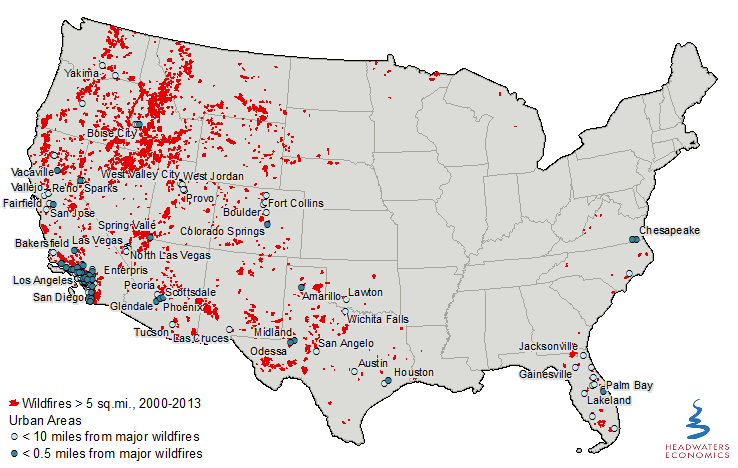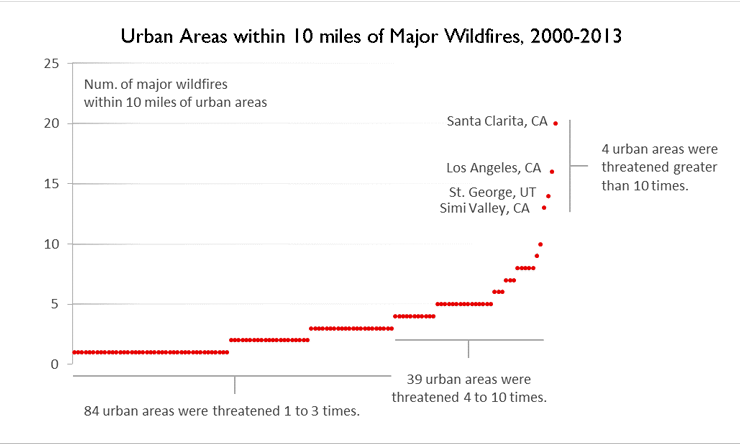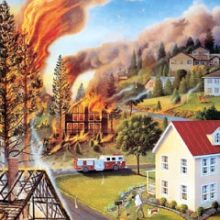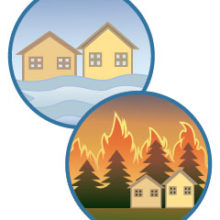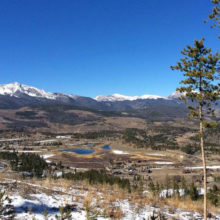- More than 15,000 wildfires burned in the continental United States from 2000 to 2013.
- During these years, 127 urban areas (cities with more than 75,000 residents) were threatened by major wildfires (fires greater than 5 square miles in area) that burned within 10 miles of the city.
- In many cases, urban areas have been threatened repeatedly by major wildfires events.
- Cities in the West are particularly vulnerable to wildfire because the West contains conditions conducive to wildfire such as extensive and remote forest areas and frequent drought conditions.
Wildfires Threaten Urban Areas
More than 15,000 wildfires burned in the continental United States from 2000 to 2013. During that period, 78 percent of wildfires burned in the West, 11 percent burned in Texas, and the remaining 11 percent burned in the Midwest, South, and Northeast. [US Historic Fire Perimeters, 2000-2013. U.S. Geological Survey, Geospatial Multi-Agency Coordination Group (GeoMAC).]
Cities in the West are particularly vulnerable to wildfire because the West contains conditions conducive to wildfire such as extensive and remote forest areas and frequent drought conditions.
Wildfire increasingly is an urban issue. From 2000 to 2013, 127 urban areas (cities with more than 75,000 residents) were threatened by major wildfires (fires greater than 5 square miles in area) that burned within 10 miles of the city.
Also be sure to read our “Land Use Planning to Reduce Wildfire Risk” report which has five case studies showing how urban areas in the West are using innovative land use planning tools to adapt to the increasing risks from wildfires.
In many cases, urban areas have been threatened repeatedly by major wildfire events.
Even when a major wildfire is 8 to 10 miles away, it can be costly for urban areas. Wildfires often damage communications, energy, and transportation infrastructure, and degrade water supply and air quality.
Many of these urban areas were threatened multiple times. Thirty-nine urban areas were threatened between four and ten times, and four urban areas were threatened more than ten times. Of the 127 urban areas, 39 were exposed to potential wildfire risk 4 to 10 times and 4 were exposed greater than 10 times. The urban areas that were threatened multiple times includes Los Angeles, San Diego, and more than 30 other southern California cities; St. George, Orem, and Provo in Utah; Reno and Las Vegas in Nevada; Boise in Idaho; and Midland and Odessa in Texas (see this Appendix (pdf) for data by each urban area and fires within one-half and ten miles).
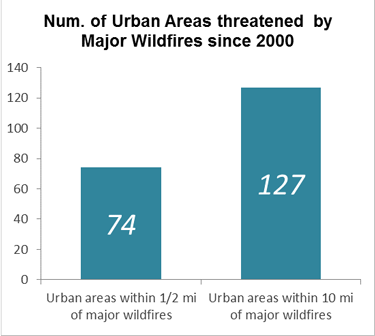 The most costly wildfires, in terms of both suppression and damages, are often those that burn near or in urban areas. From 2000 to 2013, 74 urban areas had major wildfires burn within one-half mile of their incorporated boundaries.
The most costly wildfires, in terms of both suppression and damages, are often those that burn near or in urban areas. From 2000 to 2013, 74 urban areas had major wildfires burn within one-half mile of their incorporated boundaries.
The majority of urban areas that experienced major wildfires within one-half mile were in southern California. Other urban areas within one-half mile of major wildfires included: Chico and Tracy in northern California; Tucson and the greater Phoenix area in Arizona; Reno, Nevada; Boise, Idaho; Colorado Springs, Colorado; Houston, Odessa, and Amarillo in Texas; Chesapeake, Virginia; and Palm Bay, Florida (see Appendix (pdf).
Consequences of Urban Wildfires: Costs, Homes at Risk, and Infrastructure Damage
Using statistics from Incident Status Summary Reports, we also analyzed the characteristics of wildfires within 10 miles of an urban area. [Historic Incident Status Summary (ICS-209) reports.]
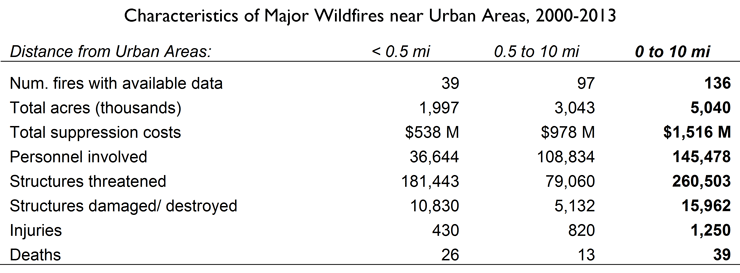
Between 2000 and 2013, 136 wildfires within 10 miles of urban areas burned more than 5 million acres with total suppression costs in excess of $1 billion. These “urban wildfires” threatened over 260,000 structures, damaged or destroyed nearly 16,000 structures, injured 1,250 people and killed 39.
Percent of Major Wildfires that Threaten Urban Resources, 2000-2013
As Americans continue to build in threatened areas, wildfires will become more frequent, threatening lives and structures.
Moreover, climate change and other factors are catalyzing urban exposure to major wildfire events, and imperiling important urban resources like transportation infrastructure, transmission lines, natural resources, water transport infrastructure, cultural resources, schools, hospitals, public buildings, and air quality, causing inextricable costs to communities and governments (local, state, and federal) and impacting millions of people.
The data below uses the ICS reports to show threats to residences, infrastructure, and other resources like water plants or schools.
 Urban wildfires disrupt the lives of millions of people each year, threatening residential areas and assets. Of major wildfires that threatened urban areas between 2000 and 2013, 95% of those that burned within one-half mile of an urban area threatened at least 100 structures, 69% threatened at least 1,000 structures, and 85% resulted in mandatory evacuations. Of major wildfires that burned one-half to 10 miles from urban areas, 81% threatened at least 100 structures, 26% threatened at least 1,000 structures, and 73% resulted in evacuations.
Urban wildfires disrupt the lives of millions of people each year, threatening residential areas and assets. Of major wildfires that threatened urban areas between 2000 and 2013, 95% of those that burned within one-half mile of an urban area threatened at least 100 structures, 69% threatened at least 1,000 structures, and 85% resulted in mandatory evacuations. Of major wildfires that burned one-half to 10 miles from urban areas, 81% threatened at least 100 structures, 26% threatened at least 1,000 structures, and 73% resulted in evacuations.
 Wildfires also disturb urban areas by damaging expensive infrastructure. Of major wildfire events within one-half mile of urban areas, 36% threatened communications infrastructure, 79% threatened energy resources (transmission lines, oil reserves, renewable energy sources, etc.), and 87% threatened transportation infrastructure (roads, interstates, railways, public transit, etc.). Of wildfires one-half to 10 miles from urban areas, 23% threatened communications, 53% threatened energy resources, and 64% threatened transportation.
Wildfires also disturb urban areas by damaging expensive infrastructure. Of major wildfire events within one-half mile of urban areas, 36% threatened communications infrastructure, 79% threatened energy resources (transmission lines, oil reserves, renewable energy sources, etc.), and 87% threatened transportation infrastructure (roads, interstates, railways, public transit, etc.). Of wildfires one-half to 10 miles from urban areas, 23% threatened communications, 53% threatened energy resources, and 64% threatened transportation.
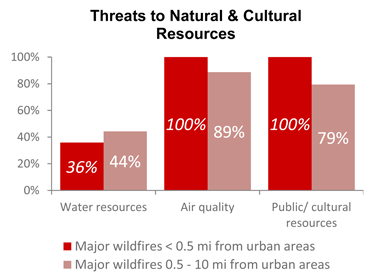 Further, environmental and cultural resources are frequently threatened by wildfire. Thirty-six percent of major wildfire events within one-half mile of urban areas threatened water resources (water quality, waste water treatment plants, etc.), 100 percent threatened urban air quality, and 100 percent threatened public or cultural resources (schools, hospitals, archaeological sites, police stations, major landmarks, places of community value, statues/art, etc.). Forty-four percent of major wildfires within one-half to 10 miles threatened water resources, 89 percent threatened air quality, and 79 percent threatened public or cultural resources.
Further, environmental and cultural resources are frequently threatened by wildfire. Thirty-six percent of major wildfire events within one-half mile of urban areas threatened water resources (water quality, waste water treatment plants, etc.), 100 percent threatened urban air quality, and 100 percent threatened public or cultural resources (schools, hospitals, archaeological sites, police stations, major landmarks, places of community value, statues/art, etc.). Forty-four percent of major wildfires within one-half to 10 miles threatened water resources, 89 percent threatened air quality, and 79 percent threatened public or cultural resources.
Discussion, Tools, and Reducing Future Risk of Wildfire to Communities
Communities already face a number of challenges to live more safely with wildfire. For example, the six worst fire seasons since 1960 have occurred since 2000.
Bigger wildfires are generally the result of several factors: biomass fuel loads have risen due to historic management practices; changing climatic conditions—higher temperatures, widespread drought, earlier snowmelt and spring growth, and expanded insect and disease infestations—have increased the size, severity, and length of wildfire seasons; and, expanding development in or near wildfire prone areas at risk from wildfires—the Wildland-Urban Interface (WUI)—contributes to a community’s risk to wildfire.
Taken together, these developments challenge the ability of towns, counties, and cities to safely manage wildfire costs and risks. To help communities better manage wildfire dangers, Headwaters Economics has developed a number of tools for communities, officials, and agencies to use. See our Resources box above or Similar Research immediately below for more details.
